Today in Tedium: If you’re using a 2G or 3G phone to access the internet or make calls, I’m sorry to tell you that it’s going offline very soon, if it hasn’t already. T-Mobile already shut off the CDMA network for its legacy Sprint customers, while it’s expected to shut off its GSM networks at the end of the year, something Verizon is already planning to do. Networking, of course, requires a connection on the other end of the line. So to add onto my series of things that “didn’t make it,” here’s a list of networking technologies that probably aren’t a part of your life. Unless they are, in which case I encourage you to send me a message telling me how you’re still using Token Ring on your local area network. — Ernie @ Tedium
Keep Us Moving! Tedium takes a lot of time to work on and snark wise about. If you want to help us out, we have a Patreon page where you can donate. Keep the issues coming!
We accept advertising, too! Check out this page to learn more.
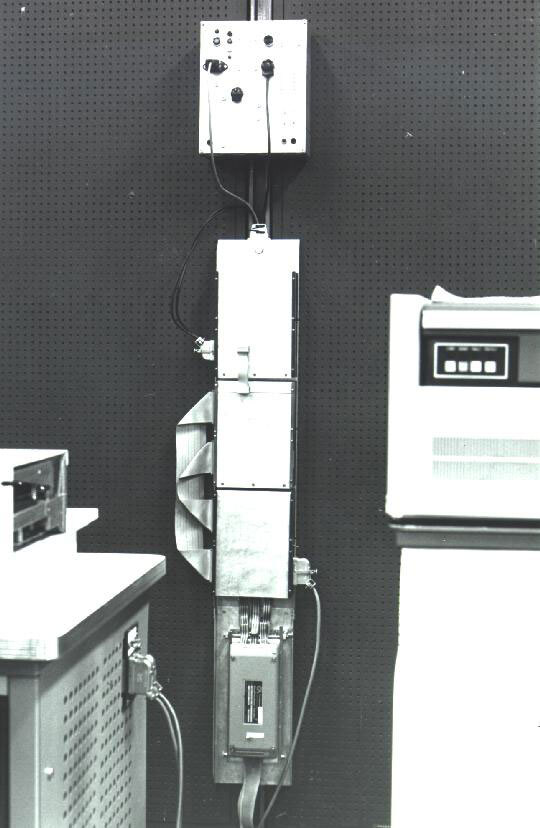
(via Wikimedia Commons)
1. Cambridge Ring
Type: Networking hardware
Date first created: 1974
Still in use? No
The 1970s were an unusual time for local area networking, as the concept was still brand new. And that meant that many formative efforts, such as the Cambridge Ring network, were developed by universities rather than companies.
The University of Cambridge, while perhaps less heralded today for its technical work, helped develop some of the earliest efforts at networked operating systems, including the Cambridge Distributed Computing System, an early network operating system that allowed for easy access to central servers.
Cambridge Ring was effectively one of the first LAN systems ever created, and inspired the industry’s growth during the decades that followed.
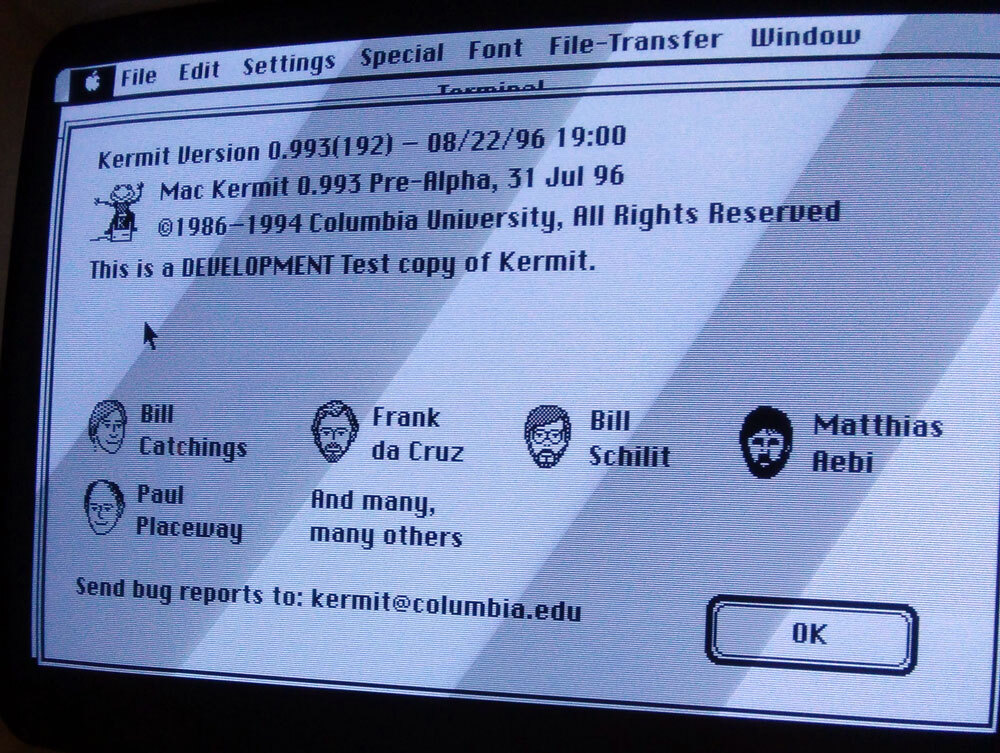
The Mac version of Kermit actually used Kermit as an icon. (via KermitProject.org)
2. Kermit Protocol
Type: File transfer protocol
Date first created: 1981
Still in use? Yes, still being updated
In case you’re wondering: Yes, Kermit is named after the Muppet, complete with permission from the Jim Henson Company.
However, it has a distinct legacy of its own. While largely remembered as a file-transfer protocol that many dial-up modem users relied on in the ’80s and early ’90s, the technology actually got its start at Columbia University as a way to allow students to transfer files across computers and platforms. (Hence the name.)
As explained on the Columbia website, the protocol was inspired because of a specific need to transfer between mainframe computers and personal computers, a use case that turned out to have significant value far beyond the university’s doors, especially for dial-up users. At a time before the cloud was really doable, it made it possible for people to download files to disk and work across platforms.
While the technology was actively maintained by the university through 2011, it was eventually spun off and is still being actively developed today.
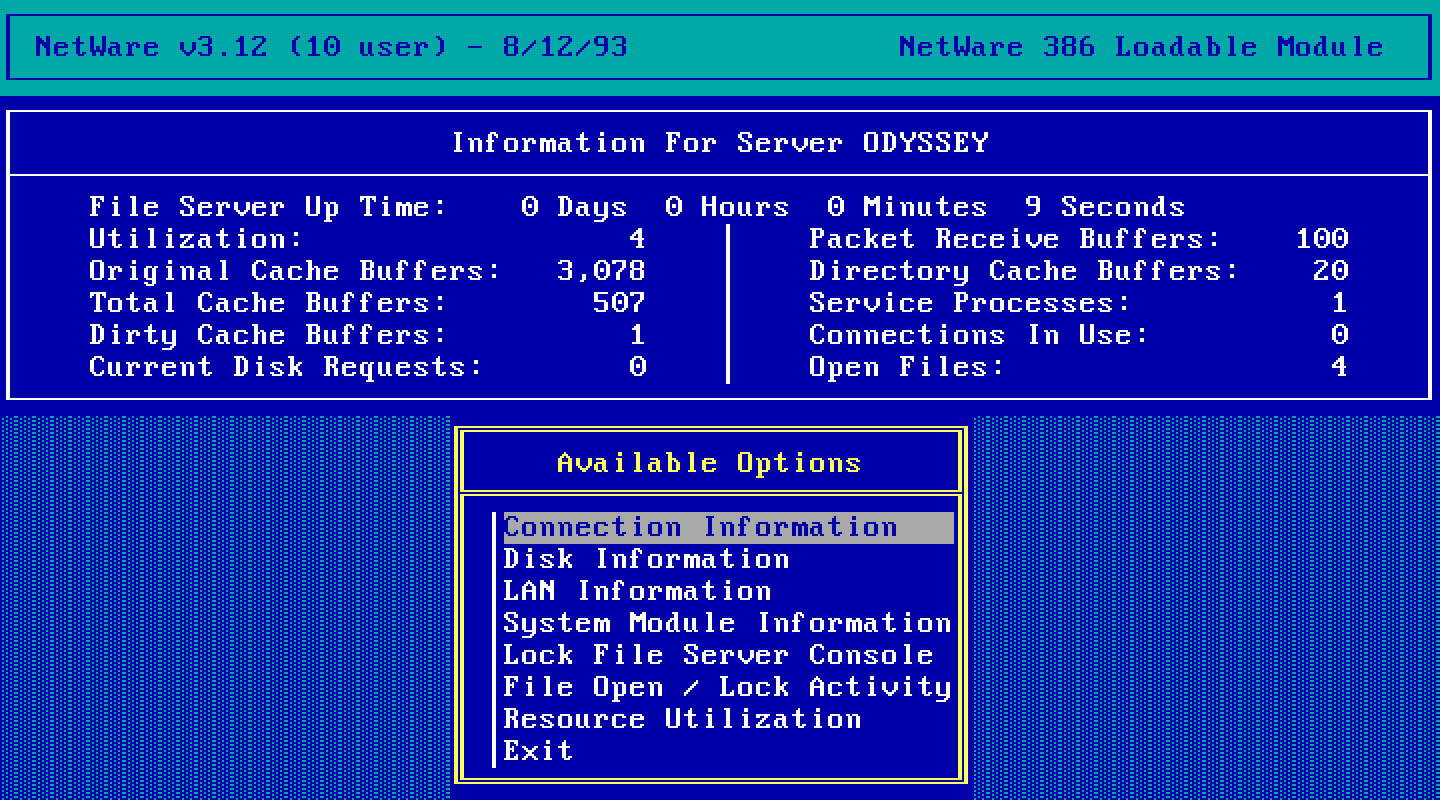
An example of Novell NetWare. (via Ncommander’s Tech Corner)
3. Novell NetWare
Type: Networking operating system
Date first created: 1983
Still in use? No
While Linux has long held the mantle of being the server operating system of choice in the modern day, Novell, a company that defined local-area networking for many companies throughout the 1980s, made a huge impact with its network operating system NetWare, representing two-thirds of the server operating system market by 1992.
But Windows’ growing influence on the market, as well as pressure from the Unix world, eventually squeezed NetWare out of the market. Novell, which was eventually acquired out of business in 2011, eventually replaced NetWare with Open Enterprise Server, a follow-up product based on SUSE Linux Enterprise Server. (Its successor company, MicroFocus, still sells it today.) If you’re using NetWare today, you’re probably a historian.
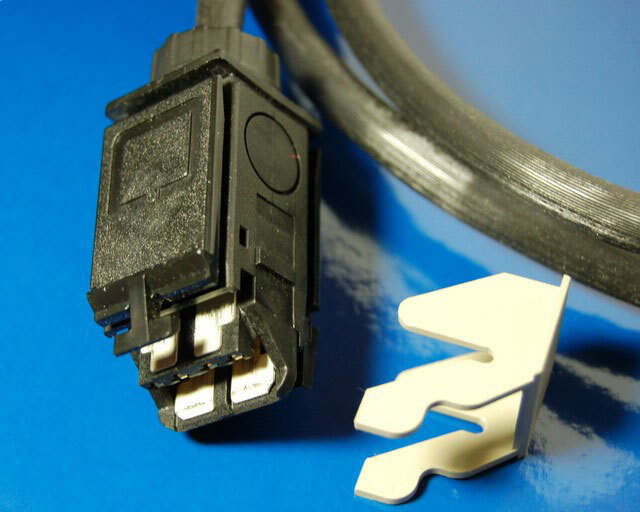
(via Wikimedia Commons)
4. Token Ring networking
Type: Networking hardware
Date first created: 1985
Still in use? Unlikely
You know how Firewire came out of the gate at significantly faster speeds than USB, only for USB to eventually lap it in future generations? That’s kind of what happened with token ring networking, an IBM-developed networking standard that competed directly with Ethernet during the late 1980s and 1990s.
Inspired directly by Cambridge Ring’s approach, researchers from IBM in Europe developed a networking technology that Big Blue eventually offered up as a standard. At first, token ring was faster than Ethernet, despite having a lower rated speed, because it was more efficient and allowed for larger packet sizes than Ethernet.
“If a computer doesn’t have a token, it has to wait until the token is freed,” TechRepublic contributor John Sheesley wrote in 2008. “This ensures that no two computers can try to access the wire at the same time, making bandwidth usage more efficient.”
However, Ethernet had two fundamental advantages that allowed it to get ahead: One, its cabling was significantly cheaper because IBM wasn’t getting royalties, allowing it to be used in more places; and two, Ethernet quickly leapfrogged the progress Token Ring had made. Soon enough, Token Ring had faded from the conversation for good.
“As we know now, Ethernet won, but if you just looked at the specs, there was no reason why it should have,” Sheesley added.

The OSI model is the 7-layer dip of technology—it would still be fine if it only had three or four layers. (Bolton/Flickr)
5. Open Systems Interconnection protocols
Type: Networking standards
Date first created: Late ’80s
Still in use? Largely usurped by TCP/IP
We take it for granted today, but it wasn’t a sure thing that we’d all be using TCP/IP technology on the internet into the present day. While the basic technology was developed by the early pioneers of the internet, other protocols existed that competed with it. One of the most prominent was Open Systems Interconnection, a general framework for computing that, among other things, offered up a detailed approach to networking protocols that, despite the large amount of standards-making that went into it, was criticized for being too complex.
However, many of the early icons of the internet, such as Vinton Cerf and Robert Kahn, were behind the basic tenets of the TCP/IP system, which was much more simplistic than the OSI model, and found quick success and growth at a time that a OSI was crawling out of the gate. We use TCP/IP today; OSI, while still having value as a reference platform, largely fell into obscurity among the general public.
Sometimes you don’t need seven layers; sometimes you can do it with one or two.
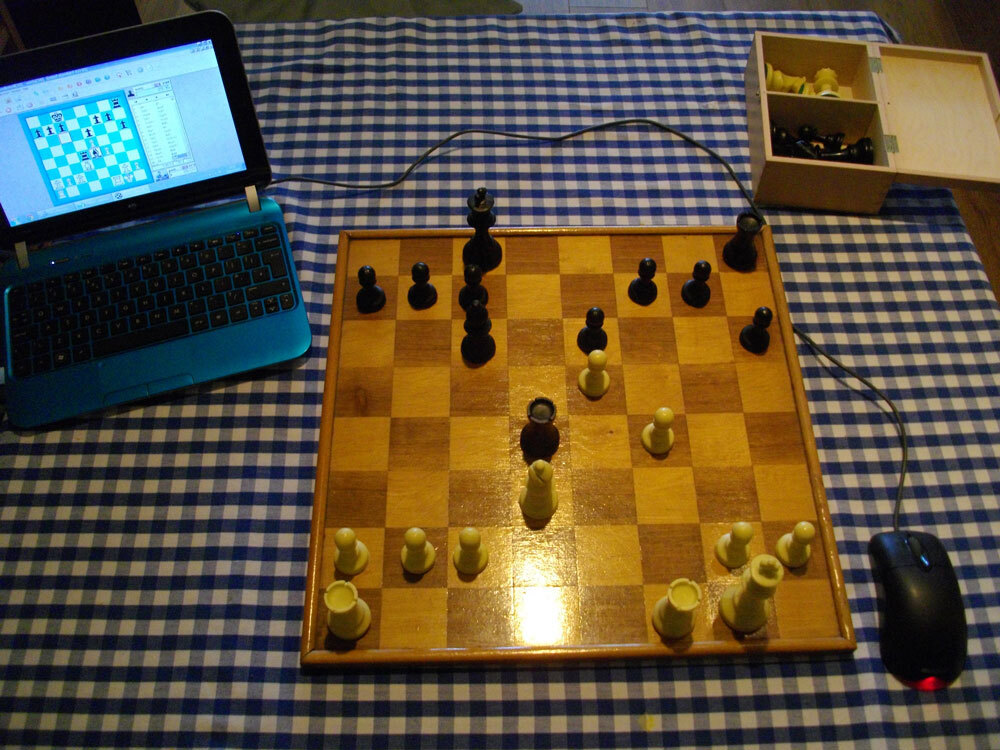
6. Internet Chess Server
Type: Networking protocol, based on telnet
Date first created: 1992
Still in use? Yes
For people who don’t play chess on a regular basis, you might think of it as a game that is played on a service like Yahoo! Games (to which I say, Yahoo! Games died a long time ago).
But the interest in chess early on in the internet’s long history created enough of an interest that a telnet-based approach to playing chess games emerged in the early 1990s. This allowed for a degree of standardization that made chess servers a common method for playing the game. Even today, the website Freechess.org offers a significant number of resources for those who want to play chess over the internet, complete with dedicated graphical clients.

An example of a GeoPort-compatible modem. (Derek K Miller/Flickr)
7. Softmodem/Winmodem/GeoPort
Type: Networking hardware/modem
Date first created: Early ’90s
Still in use? Probably, somewhere
Anyone who has used a traditional modem from the 1980s knows that they have one specific problem that makes them frustrating to use: Simply put, they feature a speed limit. A 2400-baud modem isn’t going to go any faster than 2400 baud.
Softmodems tried to solve this problem by being developed to utilize digital signal processors (DSPs) instead of dedicated discrete components. This cut down on hardware costs, but it also made modems more upgradeable as they could be kept up to date with quickly improving modern modem speed standards.
That’s the good part. The bad part with softmodems in many Windows devices is that they directly competed for CPU resources at a time the CPU was still relatively slow. (This was later worsened by models of the softmodem that got rid of the DSP entirely, relying only on the CPU, which gained DSP capabilities with the Pentium MMX processor.) Additionally, since they relied on proprietary drivers, softmodems were a nonstarter with many users of open-source software, due to the lack of drivers.
While similar in function to the softmodem approach, the Apple Macintosh’s GeoPort implementation, first introduced with the Quadra 660AV and 840AV models in 1993, had a specific difference that made them functionally different from a softmodem. Basically, Apple included a digital signal processor within the computer itself that a modem could take advantage of, allowing Mac-based modems, while still external, to be smaller and more compact. (When the faster PowerPC architecture was first introduced, it started to utilize the CPU architecture.) However, they suffered from many of the same problems as other softmodems did—in that they slowed down the system and degraded the quality of the modem connections.
In the end, softmodems gained a reputation of being underpowered for the task, even if they could be upgraded to support faster specifications.
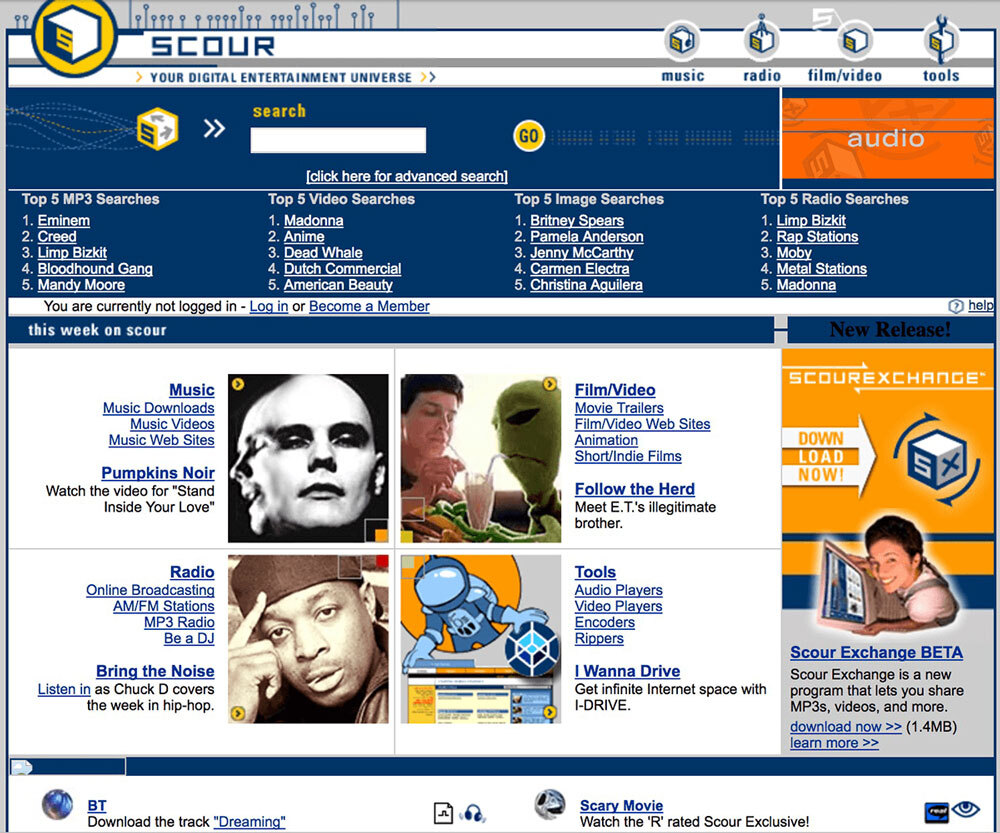
The Scour website, which is much more famous for the entrepreneur it generated than the network itself. (via App Institute)
8. Scour Exchange
Type: Peer-to-peer file sharing
Date first created: 1997
Still in use? No
You probably know a lot of peer-to-peer file transfer tools that aren’t Scour Exchange, with the most obvious historic one being Napster.
But Scour, a multimedia search engine that relied on fairly common SMB shares, actually predated Napster by more than a year and is perhaps the grandaddy of modern file-sharing software. While unheralded for this, it also has a notable pedigree: It was built on the campus of UCLA by a number of computer science students almost exactly 30 years after the original ARPAnet was developed there.
Today though, Scour—which, of course, faced numerous lawsuits during its lifetime—is best known as the first startup that Uber co-founder Travis Kalanick worked at, although referring to him as a co-founder of Scour might be a bit strong. Of course, given the market he was in, you might not be surprised to find out that Scour was sued by the movie industry for a lot of money—but you might be surprised to find out that the company’s primary funder was Michael Ovitz, the cofounder of the prominent talent agency CAA and a former president of Disney—aka the kind of person who would have otherwise sued Scour over its existence.
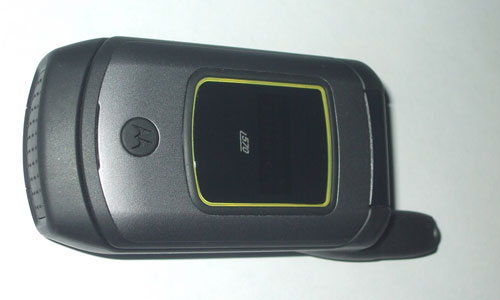
The Motorola i570, a notable Nextel phone. (Varias Personas/Flickr)
9. iDEN
Type: Cellular networking technology
Date first created: 1994
Still in use? Specialized use cases, on its way out
If you know the walkie-talkie phones that were all the rage during the era of Nextel, that’s what iDEN is. Developed by Motorola in the 1990s with the input of Nextel’s predecessor company Fleet Call, it gained popularity among users from that early era who wanted the benefits of a walkie-talkie and a cell phone in a single device.
Later in its life, a 3G-based successor technology, called WiDEN, was developed, but as with Nextel itself, the technology fell apart after Sprint acquired Nextel in 2005 and immediately tore down the WiDEN network Nextel had built in favor of its own CDMA network. Soon enough, the only “widen” that would be associated with Sprint Nextel would be the phrase “net losses widen.”
As for iDEN, Sprint’s version was shut down in 2013 in favor of 4G LTE, while the killer push-to-talk feature lives on in smartphone apps everywhere.

This thing used to be my secret weapon against disabled WiFi. (CLEAR)
10. WiMAX
Type: Large-area wireless networking
Date first created: 2001
Still in use? Specialized use cases
About a decade ago, when I worked out of coffee shops a lot more as a semi-professional blogger, I purchased a CLEAR Spot modem that allowed me access to the internet on the go in an era before smartphone tethering became common.
This modem relied on WiMAX, a wide-area networking specification that could be best described as a combination of Wi-Fi and 4G internet. It wasn’t perfect—I found that CLEAR connections were useful when Wi-Fi wasn’t an option, but it often didn’t work quite so great at times—but it was popular enough that more than 10 million people used it at the technology’s peak in the early 2010s. Eventually, the company—which was owned by a huge number of other companies that invested in municipal internet—was sold off to Sprint, which shut the network down in the years before Sprint’s eventual sale to T-Mobile.
The WiMAX technology is still out there, but as a hint of where it’s being used today, the first image that shows up on the WiMAX Forum website is a picture of an airplane.
The thing that’s really fascinating to think about in regards to this piece is the fact that, while we think of networking tech as largely standardized today, the truth is, it too had its own format wars.
Certainly, there’s a reason why CDMA beat out iDEN, why Token Ring lost to Ethernet, and why TCP/IP is driving the packets that led you to read this article.
But by the time we largely got the internet, we had many of the base elements mostly down. And the result of those base elements, we were able to keep building. Those were the roots from where we got all the things we appreciate today, whether walled gardens or the open internet.
May the many networking protocols we rely on every day help you find what you’re looking for.
--
Find this one an interesting read? Share it with a pal.





